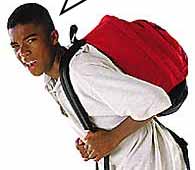

Carrying the Back Pack Issue into the School This section is compiled by Frank M. Painter, D.C.
Send all comments or additions to: Frankp@chiro.org




Originally Printed in: I.C.P.A. Newsletter November/December 1999
By: Jeanne Ohm, D.C., F.I.C.P.A.As academic requirements are raised up, so are the amounts of books students are carrying to and from school. Parents, school officials and health care providers have growing concerns with the increased amount of weight being carried each day. According to a recent news article, the issue has taken on serious implications and pediatricians have said that school children should not carry more than 10 % of their own body weight. Dr. Wayne Yankus, of the American Academy of Pediatrics says, "There is a growing concern that youngsters may have long term back problems from trudging about with such heavy loads. It typically puts them off balance and gives them a posture that promotes low back pain. A lot of kids don't suffer it immediately, but over the long run they might."
David Pascoe, a professor and exercise physiologist at Auburn University researched the effects of backpacks on children between the ages of 11 and 13. Two-thirds of the children reported having muscle soreness. He discovered significant differences between the alignment of the spine in children who used both straps and those who carried the bags on one shoulder.
The Consumer Product Safety Commission estimated more than 3,300 children ages 5-14 had been treated in emergency rooms last year for injuries related to book bags. Visiting our local high school, the school nurse confirmed in that particular week alone, two students had visited her office for injuries related to backpacks. One student was complaining about lower back pain, the other had a swollen scaleneus anticus muscle on the side carrying the pack.
With permission from the principle, we went to the high school and randomly weighed students and their packs. We recorded gender, age, and whether or not they carried the packs on one or both shoulders. The ages of the students ranged from 14-17. Our first finding was that female cooperation was less than the males, as they did not want their weight revealed. The males, on the other hand did all they could to press harder onto the scale to increases their weight. Statistically, the female pack weight per body weight was significantly higher than the males, averaging at 16% compared with the male 13 %. This is because the females' packs weighed more than the males' packs (showing a higher level of homework compliance) and the females have a generally smaller body weight than the males . This also gave me the incentive to set up a similar survey in the middle school where the students have a more equalized interest in scholastics and the males' bodies are closer in size to the females.
The majority of the students suggested I come back at the beginning of the week stating that their packs were significantly heavier at the beginning of the week. Almost every student asked if this study would lead to less homework. Many also expressed their parents' concern for the heavy loads and it was apparent that follow-up in the schools with biomechanical safety tips is both necessary and appropriate for students. As chiropractors, we have the knowledge and ability to provide applicable information and solutions for these kids. My suggestion is for us to take the lead on this issue and make a significant difference in the spinal health of the children in your communities.
Jeanne Ohm, DC, FICPA is in private practice in Media, PA and is Secretary of the ICPA, Inc. Board of Directors. Dr. Ohm is a member of the I.C.P.A.'s Distinguished Speakers Bureau and is available for speaking engagements through the ICPA.

Return to BACKPACKS
Return to KIDS NEED CHIROPRACTIC


| Home Page | Visit Our Sponsors | Become a Sponsor |
Please read our DISCLAIMER |
